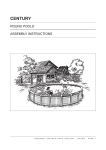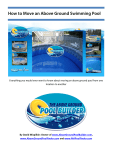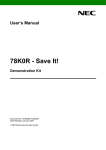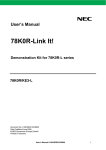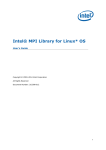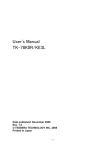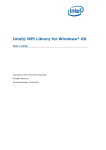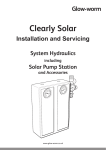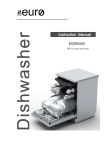Download ROUND Pools CENTURY Operating instructions
Transcript
CENTURY OVAL Pools ASSEMBLY INSTRUCTIONS ASSEMBLY INSTRUCTIONS CENTURY - OVAL - page 1 Installation Instructions 3.Do not attempt to lift the heavy boxes by yourself. To HOW TO USE THESE INSTRUCTIONS Be sure to read these instructions completely before reduce the possibility of personal injury, have someone help you move heavy boxes (pool wall, liner, etc.). beginning the installation of your pool. ATTENTION: warning Always use these assembly instructions to install 1.Your pool must be level within 2-3 cm all around. your swimming pool. Ignore any English instructions An unlevel pool may cause excessive stress on included with the pool, as the size will be in inches, etc. the pool frame. A pool which is not level may ATTENTION: Check the pool parts with the English cause a lot of pressure on the frame. This may parts lists. result in pool failure which could cause serious personal injury. These are installation instructions for the installation of 2.Your pool must be on undisturbed soil, preferably several sizes of round pools. Use the pool parts list and filtered sand. Filled up sand, sudden slopes within extensive illustrations to identify your pool parts; then 15 cm or the water runoff may cause a cave in of read these instructions and follow the steps that pertain the subsoil. This could cause pool failure and may to your pool assembly. cause personal injury. 3.Always install the Warning Sign. The decal is Doughboy cannot be held liable for damage caused by designed to warn you, your friends and loved ones careless or improper installation. Your warranty is void that your pool is to be used for swimming and wad- if the pool assembly and installation instructions are ing only. Do not allow any form of horseplay in or not followed exactly, or if the pool design is altered in around the pool. Failure to follow this warning can any way. lead to severe personal injury. Read the “Safety First” booklet (in English). Contracted Installation 4.Use stabilised sand as a pool cove. Common sand Doughboy is not affiliated with any professional pool can easily erode and allow the pool liner to rupture installers and cannot assume any responsibility for which may cause pool failure or personal injury. installation mistakes made by the homeowner. If 5.Secure your pool when not in use. Ladders and the pool is installed by others, please supervise the gates should be secured to reduce the possibility installation and make sure that the correct installation of unauthorised entry and possible serious method is applied. accidents. 6.Always repair liner leaks. Continued leakage Change of pool design between the pool wall and liner can cause wall Doughboy expressly reserves the right to change or damage to the wall which eventually may result modify the design and instruction during the course of in pool wall failure. This could result in personal our manufacturing procedures, without incurring any obligation or liability to reapply such modifications on products previously or currently sold. injury. 7.To reduce the risk of possible electrical shock, never install your pool under overhead wires. 8.Do not alter your pool as this may cause pool fail- CAUTIONS ure. Your warranty is void if the pool is altered. 1.Do not attempt to install pool wall on windy days. 9.Do not install a diving board, pool slide or any An unsupported pool wall can easily blow down and other recreational accessories for use during div- may thus cause personal injury. ing, sliding or jumping into your pool. 2.When assembling your pool, keep the parts not 10.ATTENTION: Do not install the pool liner at tem- currently used in an area out of the way. Unpacked peratures under 16ºC. At lower temperatures the parts are easily tripped over and may be damaged liner’s elasticity is too limited for proper installation. or cause personal injury. ASSEMBLY INSTRUCTIONS CENTURY - OVAL - page 2 POOL SIZES Where to position my pool? Before you start building your pool, pay attention to the 6,10 x 3,60m following points: 1.Garden fence. 2.Trees, roots, overhanging branches and falling pool radius clearance radius leaves. 3. Underground wiring or cables. 4.Position pool with regard to sun terrace or sunken 301 sitting area. 301 177 177 5.Position pool with regard to the sunshine. 6. Supervision of small children. 360 210 centerline 244 7. Convenient location of filter and pump. string line maatlijn 8. Convenient electrical outlet for the pump 9. 2 or 3 people for assistance during assembly. 10.Do not build in case of strong wind. 11. Walking space around your pool (60 cm). 310 stake side support support clearance 12.Put your pool on a level underground. 7,30 x 3,60m 13.In case of building the pool into the ground: groundwater level. clearance radius pool radius MATERIALS AND TOOLS NEEDED (Not included) 406 185 Materials: 360 406 177 177 1. 12 nails, 4 cm long centerline 366 2. Patio blocks, 1 per stud 177 3. Roller masonry or kite string 245 string line 177 310 4. Binder clips 5.Straight board, 5 x 10 cm diameter stake side support (Length, please refer to Step 1) support clearance 6. Scotch tape 5 cm wide 8,50 x 4,90m 7. Wooden stake 5 x 5 cm, 50 cm long 8. Sub-liner pool radius clearance radius Tools: 1. Carpenter’s level 436 2. Carpenter’s saw 3. Fibre tip pen 251 4. Stanley knife 490 436 237 237 366 5. Star + regular screwdriver 237 6. Hammer 274 centerline string line 237 7. Shovel / barrow 8. Rake 370 stake side support 9. Tape measure support clearance ASSEMBLY INSTRUCTIONS CENTURY - OVAL - page 3 POOL LAYOUT STAKES AND STRING LINES Step 1 Step 3 string line support width level tops string line string line centerline of pool clearance radius side support excavations (see step 4) string line locations By means of the plan you determine the layout of the Locate 4 stakes C, D, E and F in accordance with indi- clearance. Locate stakes A and B (in accordance with cated measures of the plan of your pool. Attach strings indicated dimensions) and make from there 2 circles between C and D, then E and F. Now mark the assem- for the clearance. bled side supports, as indicated on the plan. GROUND LEVELING SIDE SUPPORT EXCAVATIONS Step 2 Step 4 5 x 10 cm leveling board 3,6 m wide pool = 2,45 m long string line locations drill hole nail stake level side area level area clearance radius Clear and level the pool area in the clearance as indicat- Carefully dig out side support trenches following ed. For a firm ground it is better to remove high points dimensions above. than filling in low spots. Remove sods, stones, roots and other objects that could puncture the liner. The entire assembled pool framework must sit on flat ground. ASSEMBLY INSTRUCTIONS CENTURY - OVAL - page 4 EXPLODED SIDE SECTION INSTALL CONCRETE BLOCKS Step 5 side support assembly string line Fill with concrete skid plate horizontal beam level concrete block Figure A Legend for Figure A Place two concrete blocks into the excavations and 11/a/b= Bottom rail place the assembled side supports into each trench 16 = Screws #10 x 1/2" perpendicular, so that the front side of the side support 34 = Antiskid plate is situated to the tautly wire. 35 = Top ground support 36 = Vertical base 37 = Pressure pad 38 = Vertical pressure pad 39 = Rail connector 40 = Screws #12 x 3/4" 41 = Screws 3/8-16 x 3-1/2" 42 = Screws 3/8-16 43 = Screws 1/4-20 x 1/2" 44 = Screws 1/4-20 45 = Screws #10 x 3/8" 46 = Side support POSITION SIDE VERTICAL SHIMS (WITHOUT PROTRUDING HORIZONTAL BEAM) Step 5a slope side support assembly level fill with concrete firm undisturbed earth slope downward square wood of 2 cm concrete blocks Place the horizontal beams two degrees tilted in the ground. The side supports will stand straight again by the pressure of the water. ASSEMBLY INSTRUCTIONS CENTURY - OVAL - page 5 POSITION SIDE VERTICAL SHIMS (WITH PROTRUDING HORIZONTAL BEAM) INSTALL PRESSURE PADS Step 7 Step 5b # 10 Screws Begin here slope # 12 Screws # 12 Screws side support assembly pressure pad level fill with concrete firm undisturbed earth Work from left to right concrete blocks notch out Place the horizontal beam level. The side supports will Fix the pressure pads both to each other and to the stand straight again by the pressure of the water. horizontal beams of the side supports and make sure everything is filled up. DIG OUT FOR PRESSURE PADS INSTALL BOTTOM RAIL LOCATOR Step 6 Step 8 62 cm side support assembly 2,5 cm Make scribes approx. 2,5 cm deep at the spot of the pressure pads side vertical assembly 61 cm bottom side rails stamped “S” pressure pad 5 cm bottom rail locator Remove dirt at the spot of the pressure pads so that the pressure pads can be assembled on the horizontal beams of the side support assemblies. Assemble the bottom side rails stamped “S” between the side vertical assemblies, as indicated on the plan. ASSEMBLY INSTRUCTIONS CENTURY - OVAL - page 6 INSTALL BOTTOM RAILS NOTE: Place enough sifted earth into the pool area to cover the pressure pads. With a high groundwater level Step 9 (in ground pool) we advise to install a concrete floor. Only for 16" and 21" pools, stamped TR (4 pcs) Bottom rails stamped 12", 16", 18" and 21" INSTALL WALL JOINTS Step 11 Level Bottom rail connector Bottom rails Screw Optional sunk patio blocks Bolt Slide the bottom rails into the vertical end caps, groove up (see plan). Start on opposite sides of the side vertical assemblies with the end rails stamped with 12". When The wall joints overlap (see plan). If joint piece doesn't the bottom condition is not optimal, place a patio block slide on easily, correct the side supports until the joints under every vertical end cap (sunk on bottom level for fit perfectly. See to it that the round shape is preserved. extra certainty). Connect the wall joints by means of the bolts and screws included in the packaging. Attention: the screwhead must be on the inside of the pool. Smooth INSTALL WALL the screws. Fix the protective strip with tape. Step 10 INSTALL VERTICALS & END CAPS steel pool wall Step 12 large dia stabilizer rail large and small stabilizer rails telescoped around ends of pool only stabilizer rails sifted earth vertical end cap start wall at center of vertical end cap Remove steel pool wall from carton. Note ‘Up’ arrow on wall. Determine starting point of wall from preliminary vertical planning, depending on the place of the pump and the filter. The skimmer opening will be at the inside end of the wall coil. Always start with the center of a vertical Install the verticals, so that the screw aperture is at end cap. Always uncoil 1,5 m and insert bottom edge the front side on top of the vertical. The construction into groove in bottom rails. When the ends of the pool is connect by screws. Position vertical end cap over do not connect completely, correct this by telescope the vertical (see plan). A drop of oil on the screws bottom rail more or less into the vertical end caps. facilitates your work. ASSEMBLY INSTRUCTIONS CENTURY - OVAL - page 7 STEEL TOP RAIL / END SECTION INSTALL TOP RAILS + HOLES CHART FOR TOP RAILS (CENTURY 6,10 x 3,60 / 7,30 x 3,60) Step 13a There are two different joints, a straight and a round joint. A, B, C straight / D round (see fig. 13 A). Four screws connect the top rails with the vertical end caps. Screw the screws in the right holes of the top rails and vertical end caps. Follow the measures of the holes chart. Holes with numbers 1 and 3 are of the inside of the pool. Holes with numbers 2 and 4 are of the outside of the pool. Figure 13A Figure B Legend for Figure B Mounting end sections 1 = Covering panel 11 = Bottom rail 4 = Screws 17 = Screw 5 = Stabilising rail (large) 19 = Vertical 6 = Stabilising rail (small) 20 = Liner 7 = End cap 28 = Wall 8 = Connector 29 = Bolt 9 = Cover 30 = Nut 10 =Plastic profile 31 =Protective strip Joint A 3,60 Hole chart for ovale pools Joint A Hole 1 – Top Rail C Hole 1 – End cap S3 Hole 2 – Top Rail 18/24 Hole 2 – End cap S3 Hole 3 – Top Rail C Hole 3 – End cap S3 Hole 4 – Top Rail 18/24 Hole 4 – End cap S3 ASSEMBLY INSTRUCTIONS CENTURY - Joint B 3,60 Joint B C 12 C 12 C 12 C 12 OVAL - page 8 INSTALL TOP RAILS + HOLES CHART FOR TOP RAILS (CENTURY 8,50 x 4,90) COVE Step 14 Step 13b 15cm Cove 10cm There are two different joints, a straight and a round joint. A, B, C straight / D round (see fig. 13 B). Four screws connect the top rails with the vertical end caps. Screw the screws in the right holes of the top rails Warning: Use sifted earth, so that the cove can not crumble. and vertical end caps. Follow the measures of the holes chart. Holes with numbers 1 and 3 are of the inside of the pool. Important step: Make on the inside of the steel wall a Holes with numbers 2 and 4 are of the outside of the slant elevation of sifted earth of around 15 cm high and pool. wide. This is a vital structural element that prevents water pressure from forcing the pool liner out under the Figure 13B bottom rail. LINER SEAM POSITIONING Step 15 Please check if the article number of the liner corresponds with the article number on the packaging. Liner / inside Side seam Water side Liner / inside Joint A 4,90 Joint B 4,90 Item number Bottom seam Check the pool floor again for stones, glass and other sharp objects. Fill in all footprints and other unevenness Hole chart for ovale pools Verbindung A Hole 1 – Top rail C Hole 1 – End cap S3 Hole 2 – Top rail 18/24 Hole 2 – End cap S3 Hole 3 – Top rail C Hole 3 – End cap S3 Hole 4 – Top rail 18/24 Hole 4 – End cap S3 on pool floor. As floor sealing and extra protection of your Verbindung B C 16 C 16 C 16 C 16 liner it is advisable to cover the floor with water-resistant underlay, that you can fasten with tape to the underside of the steel wall. Now place the liner on the top rail and check as indicated. Note: The embossed side of the liner will be the water side. ASSEMBLY M OI N NS TA TR GU E CI TNI SOTNRSU C T E INET U CR EY N T- U O R VY A -L P- A pGaI g Ne A 9 1 STRETCH LINER into the pool until the desired tautness is achieved and re-clamp the binder clips. Remember that you are Step 16 monitoring a minimum tightness of the liner over rail that will control the liner seating itself against the pool floor and up the side with no wrinkles. When the water (5 cm) bottom liner seam is covering the pool floor, the liner on the pool floor must be without pleats and wrinkles. If this occurs, pull and lift the liner wall just enough to stretch out wrinkles or pleats by the water weight. There should be just barely enough tension on the liner, until the floor is filled with approximately 20 cm water and the liner is connected against the metal wall. The clamps can be bought at several tool shops (Preferably use synthetic clamps). Work in both directions with unfolding the liner and drape it over the top rail and down the sides for about 60 cm. CONTINUE FILLING POOL The liner should be about 40 cm above the pool floor in the center only. The bottom edge seam of the liner Step 18 should be inside the pool about 30 cm from the top rails (see plan). water level FILL POOL Step 17 clamp After the pool is filled, the bottom liner seam of the liner must be totally around in the pool must be close to crossing of the bottom wall. Do not worry about the strength of the liner, the strength is calculated on garden hose cardboard binder clips 1,5 x the original size. When the bottom liner seam is not on the right place, there is a chance that you have not enough liner left to place on the top border, so that Before filling the swimming pool, hold the liner in place you have to start again with placing the liner. by attaching two binder clips over folded cardboard on the underside of each top rail. Because of the water weight, the liner will be stretched with no wrinkles. Check during filling the pool the liner for extreme tautness. Binder clips do not self-release, so release binder clips with extreme tautness and allow the liner to feed back A S S E M B L Y MI O NN STA RG UE C TI INOSNTSR U CC E TN ITEU R CY E N- T O UV RA Y L - - P pA aGgI N e A1 0 1 PROCEDURE TO ATTACH LINER Now assemble the skimmer, inlet and filter as indicated on the special enclosed instruction. Then fill the pool to Step 19 the indicated level on the skimmer plate. fold back liner from 3 top rails top connector top rail stabilizer rails vertical end cap With the help of two or three people, raise and hold the liner up from any three top rail sections. Be careful and never allow the liner to fall back into the pool. When 1 man is holding the liner, the other folds back the vertical end caps, the top rails and top connectors from three top rails (see plan). INSTALL COPING AND STABILIZER RAILS Step 20 small dia. stabilizer large dia. stabilizer plastic coping liner return hem pool wall Make a return hem as illustrated and smooth the liner against the wall (see plan). Place the coping over the liner and the stabilizer rails over the coping after pushing it together about 15 cm. Replace all parts removed in step 19 and repeat the same steps for all 3 top rails until you assembled the entire pool. A S S E M B L Y MI O NN STA RG UE C TI INOSNTSR UC CE TNI TEU C RE Y N- T O UR VA Y L- -Pp A aG gI N e A1 1 SUPPLEMENTARY INSTRUCTIONS FOR BUILDING A POOL IN THE GROUND To avoid that material rolls onto the site where the pool is to be constructed, the location where the pool is to INSTALLATION OF SKIMMER AND INLET be constructed must be in the most elevated part of the The skimmer and the inlet have to be installed before garden. The surrounding landscape should be lower the pool is filled with water and before the pool is filled than the pool. Attention, the water level of the pool up with stabilized sand. During the installation of the should also be above the groundwater level during the internal lining and the skimmer, the lead through for the winter (water level 15 cm below the inlet). skimmer may not be created yet. Install the inlet and The specific installation such as seen in Figure 2 serves gasket. Remove the internal lining from the inlet opening only as a reference and is not representative for all pool and install the valve delivered with the skimmer. installations. The parts which may need special materi- PLUMBER’S WORK als are the lighting and chloride installations. In order to prevent that the hoses move up and down, EXCAVATING you should connect the skimmer and the inlet with rigid 1. The circumference of the excavation is the same as PVC to the filter (Figure 2). If you are using flexpipe, you the size of the pool plus 60 cm around the whole need to make sure that this pipe is not bent, before you pool. Determine the size of the excavation pertaining fill up the rest of the pool. Install the pump as closely as to the size of the pool and use for this the exten- possible to the pool in connection with the drawing in of sive installation instruction delivered with the pool. the pump. If this pump is a Doughboy Pool Powerpack, (Attention, the soil should be at least 15 cm white then you should place it below the water level. sand or stabilized sand; on top of that we recommend FILLING THE POOL a layer of styrodur or a protective blanket.) 2. The depth of the excavation is dependent on the First fill the pool with water up to approximately 5 cm height of the pool and desired terrace. Use the size away from the top edge. This procedure is absolutely such as seen in Figure 1 to calculate how deep the necessary to absorb the pressure performed on the wall excavation should be. during the application of stabilized sand. Ff the pool 3. After the pool is excavated, the frame and the wall should be installed according to the installation ins- is not filled completely with water, this can cause pool failure. truction delivered with the pool. SHUTTERING We recommend that you apply a shuttering around the skimmer before the pool is filled up.A space around the skimmer and any other accessories offer you the possiFigure 2 Specific installation Cover panel 60 cm working space around the pool 12-15 cm Fill the pool up to 5 cm below the top edge Grade (2 cm per meter) FIG. 1 - CONSTRUCTION PROVISIONS WHEN A POOL IS EXCAVATED A S S E M B L Y MI O NN STA RG UE C TI INOSNTSR U CC E TN ITEU R CY E N- T O UV RA Y L - - P pA aGgI N e A1 2 1 Feed towards pump gate of filter Check valve (Recommended) Space between the top of the pool and stabilizer sand 22 cm Retour towards return gate filter Grade 2 cm per meter Stabilisierter Sand Füllen Sie erst das Schwimmbecken, bevor Sie den stabilisierten Sand auffüllen. Valve (Recommended) PVC tube and fixtures FIG. 2 SPECIFIC INSTALLATION bility to have easy access for maintenance or repairs. IMPORTANT MESSAGE: ATTENTION: If the filling up takes place immediately Piling up of loose material between the mixture and the around the skimmer, it shall be more difficult in the futu- poor wall may push in the wall. If extra material is placed re to check the skimmer during leaks. between the mixture and the cover material to get this at the correct height, you should only use a sturdy mortar. Doughboy is in no way liable for the expenses pertaining to the finding and/or repairing of leaks, cutting, breaking off and/or removing of stabilizing sand. PREPARATION OF STABILIZER SAND Mixing ratio 1 m3 fluvial sand with 125 kg concrete. IMPORTANT WARNING: Regardless the method used for the way the stabilized sand is applied, you should pay close attention to the wall of the pool during filling to be sure that the wall does not collapse. If a dent occurs in the pool wall, someone should enter the pool to push it back. If this is not possible, you should lower the pressure to the pool wall by removing the mixture used to fill up the pool locally again so Without patio blocks With patio blocks that the dent can be removed. Then carefully fill up the pool again. You should at all times pay attention to the pool wall until the pool is completely filled up. To prevent rust on the pool wall, the water streaming out of the pool should immediately be removed from the pool wall. For this you should let the top layer run off at least 2 cm such as can Stabilized sand be seen from the illustration. After the mixture has been applied completely, you should lower the water level to the top line of the skimmer opening and cut Keep the stabilized sand 5 cm below the screw of the guard Top of the patio block Stabilized sand Keep the patio blocks 5 cm below the screw of the guard away the liner in the skimmer opening. FIG.3 - WITH/WITOUT PATIO BLOCKS A S S E M B L Y MI O NN STA RG UE C TI INOSNTSR U CC E TN ITEU R CY E N- T O UV RA Y L - - P pA aGgI N e A1 3 1 Standard SKIMMER Fig. 1 Standard Skimmer MODELS 5-2091-015 INSTALLATION INSTRUCTIONS Cover Outside pool Inlet Sand filter Pool pump PREPARATION OF THE POOL The pool should be built up the correct way based on the pool assembly and installation instructions. Approximately 70 cm water should press against the metal wall, so that there isn’t any elasticity anymore against the liner, before the skimmer is installed. ATTENTION: After the skimmer hole is cut open the liner can no longer be moved. Your standard skimmer facilitates the maintenance of your pool. Leaves and floating refuse are taken out of Skimmer installation the water and enter into the skimmer basket. Clean the 1. Remove all parts from the carton box. Remove the basket regularly to continuously keep your pool clean and hygienic. The numbers indicated between the brackets refer to the numbers of the illustration (Fig 7). cover of the skimmer by sliding it to the front and then lifting is; remove the skimmer basket. 2. Fasten the skimmer valve (7) to the skimmer (3) by using three screws (8). Push the skimmer valve into the skimmer so that the foam side is facing the bottom. 3. Install the top skimmer gasket (9) into the square opening of the metal wall; make sure that the gasket is positioned properly in front of the holes. Then Needed tools fasten the bottom gasket (10) into the vacuum con- • Crosshead screwdriver nection. Place the skimmer plate on the inside of • Screwdriver the pool, and keep the skimmer on the outside of • Stanley knife the pool. First screw tight the top angles with two self tapping screws. Press the self tapping screws through the skimmer plate and press the liner into the openings of the skimmer. Lightly tighten the self tapping screws. A S S E M B L Y MI O NN STA RG UE C TI INOSNTSR U CC E TN ITEU R CY E N- T O UV RA Y L - - P pA aGgI N e A1 4 1 Installation inlet fixture Fig. 2 1. Install the gasket of the inlet (17) into the wall opening. Insert the inlet fixture (18) through the liner and Inside pool Skimmer plate the wall starting from the inside of the pool. Make a small notch into the liner and press the inlet fixture through. 2. Now screw the inlet (16) onto the inlet fixture; turn it clockwise until the inlet end points towards the Skimmer valve Suction connection for cleaning pool bottom. 3. Install the eyeball inserted piece (20) into the eyeball (21). Insert the eyeball with the inserted piece into the inlet fixture, turn the closure (22) on top of that; make sure that the eyeball location stands in the water run- 4. Screw the rest of the self tapping screws through the ning off direction of the skimmer opening skimmer plate, liner, gaskets, wall and the corresponding openings in the skimmer. Tighten all self tapping screws manually; this to prevent damage to the skim- WARNING: Always keep the water level between the mer plate. With a Stanley knife now cut away the liner water level signs on the skimmer plate. on the inside of the skimmer plate; do the same with After installation of the skimmer check if there are leaks the vacuum inlet. (Fig 4) when the pool is filled. Continuous leaks can cause damage to the pool wall, so that eventually there is pool failure. Fig. 3 Self tapping screw Skimmer plate Gasket VACUUMING Empty the skimmer basket before suctioning. 1. Switch off the pump. Assemble the vacuum nozzle, handle and hose. A proper flexible hose provides the best suction results. Attach the free end to the vacuum adaptor (13). Gasket 2. Switch on the pump. Keep the free end of the hose Inside pool wall & liner against the outlet of the inlet fixture. Because of this air shall pass through the hose. When bubbles no ATTENTION: The gasket around the vacuum connection longer exit from the vacuum nozzle, all air has been (10) is necessary to ensure a watertight closure around removed (please refer to Figure 5/6). the vacuum connection during the suctioning off of water. Attach the suction cover (12) and the attachment of the suction cover (11) to the skimmer plate with a screw (8). Fig. 4 Cutting away liner Skimmer opening Suction connection Outside pool Fig. 5 Fig. 6 A S S E M B L Y MI O NN STA RG UE C TI INOSNTSR U CC E TN ITEU R CY E N- T O UV RA Y L - - P pA aGgI N e A1 5 1 Warning: Never try to install the cover in a suctioning Lid position if the pump is switched on. The cover might Vacuum adaptor suddenly be pulled down due to the strong suction of the pump. You may suffer personal injury to your hands or fingers. 5. When the cover is in place, you can switch on the Suction cover Fig. 7 pump and put into operation the suction of the pool floor. 6. When you are finished suctioning, you have to switch 3. Fold the cover of the vacuum opening (12) so that off the pump. Remove the vacuum hose with the it points towards the bottom. Insert the tapering end vacuum adaptor connected to it from the pool. Clean of the vacuum adaptor with the hose attached into the skimmer basket and your filter. Relocate the cover the opening by making a turning movement (Fig. 7). to the original position on the top of the skimmer. 4. The cover (2) has two functions. In the normal position is covers the top of the filter. During suc- Switch on the pump to resume the normal operation of the pump. tion, this same cover becomes the closing plate for suctioning; make sure that the pump is in the OFF position. Remove the cover, turn it 90º and let it drop to the inside and place it above the basket. Make sure that there is no air under the cover. Trapped air shall make the cover rise. STANDARD SKIMMER PARTS No. Article Amt Description 1 1300-1002 1 Skimmer basket 2 1121-1506 1 Skimmer cover 3 1121-1864 1 Skimmer 4 360-1794 1 Sticker 5 1121-1358 1 Skimmer valve 6 340-1600 1 Attachment skimmer valve 7 1107-1275 1 Skimmer valve plus attachment 8 330-1008 4 Screws 9 307-1029 1 Top of gasket 10 307-1030 1 Bottom of gasket 11 340-2089 1 Attachment suction cover 12 348-1028 1 Suction cover 13 340-1590 1 Water suction adaptor 14 330-1004 15 Screws 15 340-2090 1 Skimmer plate 16 340-1591 1 Inlet 17 307-1031 1Gasket inlet 18 340-1592 1 Inlet adaptor 19 340-1594 1 Closure disk 20 340-1595 1 Eyeball attachment 21 348-1027 1 Eyeball 22 340-1593 1 Closure for the inlet 23 360-2023 1 Operating Instructions Label A S S E M B L Y MI O NN STA RG UE C TI INOSNTSR U CC E TN ITEU R CY E N- T O UV RA Y L - - P pA aGgI N e A1 6 1 PREPARING FOR WINTER When the swimming season is over, you have to follow the instructions to get your pool ready for winter. ATTENTION! Do not remove all the water from your pool and also do not remove the liner. An empty pool can namely cause pool failure. Lower the water level - Lower the water level in your pool so that it is approximately 6” (15 cm) below the inlet fixture; maintain this water level by checking it regularly. - If you have a skimmer, then absolutely do not let the water freeze in the skimmer but rather drain this water. Check all screws and connections Anti-freeze liquid - Make sure that all installation connections and parts This liquid can be used without problems in combination are positioned correctly and that the pool wall is not with chloride products. Upon finding algae present first moved away from the bottom rails. apply a ‘shock treatment.’ The liquid should be, dis- - Make also sure that all connections are water tight. Check if there is rust solved in a pail of water, spread out equally across the water surface. During the dosage the pump should be - Correct all damages or rust spots with a varnish stick. in operation. The dosage is 0.5 litres per 10 m3, after approximately four weeks 0.3 litres per 10 m3. Check the liner (interior tarpaulin) - Make sure that the top of the liner is still overhanging ATTENTION! Never mix the liquid with other pool che- the pool wall attached to the plastic edge. Do not micals or chemicals and always add the product to remove the liner from your pool. Upon removal of the water, never the other way around. liner of the pool the warrantee becomes void. Do not pump dry all the water from the pool during the winter. If you do not adhere closely to the winter instructions, the warrantee of your pool may become void. Thus care- Leaks found fully adhere to all instructions for maintaining your pool - Make sure that there aren’t any leaks in the liner. during the winter. Leaks during the winter can cause serious damages to your pool. Pool accessories - Remove all pool accessories from the pool, including the ladder. Leave the skimmer and inlet fixture in place. The filter - Disconnect the filter from your pool and follow the filter instructions for maintaining the filter during the winter. Clean the pump and the filter for the winter (frost free). A S S E M B L Y MI O NN STA RG UE C TI INOSNTSR U CC E TN ITEU R CY E N- T O UV RA Y L - - P pA aGgI N e A1 7 1

















